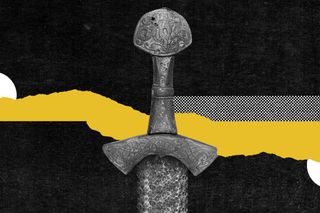
A 1,000‑Year‑Old Fossil is Challenging Sex and Gender Binaries in History
The findings challenge beliefs about gender roles in ancient societies, highlighting possibility of the respect given to non-binary persons.

The DNA analysis of a 1,000-year-old grave in Finland suggests it may have belonged to a well-respected non-binary person. The interesting discovery offers insights into how medieval societies operated, while also challenging notions of genders roles and identities.
“The overall context of the grave indicates that it was a respected person whose gender identity may well have been nonbinary,” the peer-reviewed study, published in the European Journal of Archaeology last month, noted. The underlining idea is how even early medieval society held a nuanced understanding of gender identities, rattling assumptions archaeologists — and even the society — makes about sex and gender in ancient civilizations.
The discovery goes back to 1968, when the remains of the body were first discovered with feminine attire and jewelry such as oval brooches. The researchers also found a sword placed on the person’s left side, a motif traditionally associated with masculinity. This inspired two theories: that the remains belonged to female warriors; or two separate bodies, one of a male and female, were laid to rest there.
But the modern analysis done on the fossils debunks the ideas by noting the remains belong to one person only. The researchers were able to prove this by showing the person buried had Klinefelter syndrome — when a male is born with XXY chromosome (usually, a female has XX chromosomes and a male has XY chromosome). The condition is associated with a small penis, enlarged breasts, and even infertility.
The traits of Klinefelter syndrome helped to cement the idea the person “might not have been considered strictly a female or a male in the early middle ages community,” Ulla Moilanen, one of the researchers, told The Guardian.
Previously, historians had associated medieval Scandinavian society with a hypermasculine environment, where men with feminine social roles or those who dressed in feminine clothes were disrespected and considered shameful.
Related on The Swaddle:
Emerging Brain Research Suggests Human Physiology Doesn’t Reflect a Gender Binary
What’s more is that not only does it ascertain the non-binary biological sex of the individual, but works as proof to show their status in society. “The abundant collection of objects buried in the grave is proof that the person was not only accepted, but also valued and respected.” Moreover, the high-status burial, with the body adorned with swords and fancy robes, helped them conclude the acceptance of an individual beyond the traditional binary.
The research makes it a point to discuss the bridges between gender and biological sex in medieval context. It notes, “For decades, buried individuals have been interpreted as male or female based on grave goods, and the development of osteology and genetics have brought in new methods to determine human remains as either female or male. This binary division is, however, problematic. Chromosomal aneuploidies as well as certain genetic and hormonal conditions widen the variation in biological sex, but biology itself offers little in terms of a person’s self-identification.”
Notably, finding human remains in archaeological digs generally means they are assigned one sex or the other based on the clothing and objects the fossil was found with. This also showed insight into possible gender identities held in the selection of artifacts people would be buried with. Despite progress in paleontological methods in determination of sex, it “is unclear how well the grave goods represent the gender roles and identities of the past, and whether these roles should be interpreted from a binary perspective.”
They write, “Although swords in early medieval graves in northern Europe can be interpreted in many ways, from symbols of power and social status to ancestral heirlooms, they are still often associated with masculinity and warrior ideology. While axes, spearheads, and arrowheads have occasionally been buried with female-bodied people, and may appear in graves together with feminine jewellery, swords are rare items in graves of female-bodied individuals.”
The discussion does make room to argue that the conflict arising from a gender being automatically assigned to a biological sex possibly existed even in times when humans hadn’t developed the language for it. It was only in the 1900s that separating biological sex from gender was introduced as a concept in cultural writing in the West.
However, this is not the first time evidence of non-binary persons or societal understanding has emerged. In 2018, a civilization in Hasanly, an ancient site in northwest Iran, had recognized the existence of a third gender besides “male” and “female” already 3,000 years ago, research showed. It highlighted that “many non-western societies – past or present – have a non-binary view of gender,” Ariel David noted in Haaretz.
“Embedded in that use of predetermined categories is the assumption that being male or female meant the same thing a long time ago as it does now,” Megan Cifarelli, an art historian from Manhattanville College in the U.S., told Haaretz.
In the present discovery, it is the sword that perplexed archaeologists for it defied the traditional gender idea. And while the Finnish researchers used a small sample size of DNA from the body, they believe the findings still hold.
Other historians have expressed “excitement” about the work, noting it engages with ideas of gender and identity through a historic lens. Early medieval societies “had very nuanced approaches to and understandings of gender identities,” Leszek Gardeła of the National Museum of Denmark told The Guardian.
Saumya Kalia is an Associate Editor at The Swaddle. Her journalism and writing explore issues of social justice, digital sub-cultures, media ecosystem, literature, and memory as they cut across socio-cultural periods. You can reach her at @Saumya_Kalia.
Related


The Size of A Bird’s Eye Can Be Pivotal To Conservation Efforts, Experts Say
